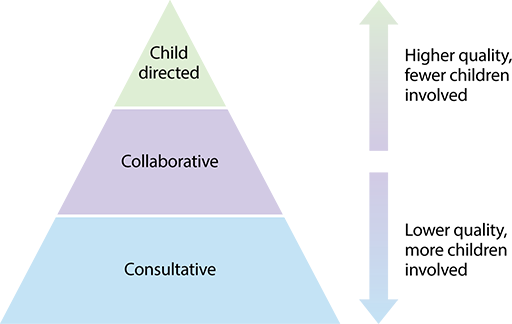Levels of involvement
Children can be involved at a number of different levels, and their age, capacity and capabilities will have a bearing on what is feasible:
- Consultative involvement means collecting information from children as part of monitoring, for example, asking children their opinions about what they think is important and what might be monitored.
- Collaborative involvement means sharing decisions about what is monitored and what actions should be taken in response to particular issues.
- Child-directed involvement means that activities are initiated or led by children, and adults provide support to enable this to happen. An example of this would be, for example, supporting older children to obtain views from younger children through use of group drama.
Child-directed activities represent the higher quality of involvement, but because of the requirement for additional time and capability in these activities, it is usually only possible to involve fewer children. Figure 2.2 represents these different levels of involvement, with the highest point representing fewer children involved in higher quality engagement.

Top ten tips for involving children in monitoring and evaluation
- Involve children in topics and projects that will benefit them the most.
- Consider and manage the ‘costs’ to children, for example time, embarrassment, intrusion to privacy, anxiety.
- Ensure privacy and confidentiality so they have room to speak freely without fear of being reported.
- Think about selection and how you will be inclusive of the different groups, like boys and girls, disabled children, etc.
- Think about expenses, payments or other appropriate rewards. Children need to be provided compensation, food, toys, etc. during their participation processes including giving them time to play in between.
- Involve children in reviewing the plans and methods being used, not just the implementation.
- Make sure children and parents/carers are informed about the purpose.
- Make sure consent/assent is understood and freely given.
- Ensure children get information and findings in a format appropriate to their age and needs.
- Ensure there are no negative consequences or impacts on participants, they should be protected in all these processes from adverse outcomes of their participation.
Some of these tips and issues are discussed in more detail in Module 4. There are also some references at the end of this module.
2.5 Involving children in monitoring and evaluation
